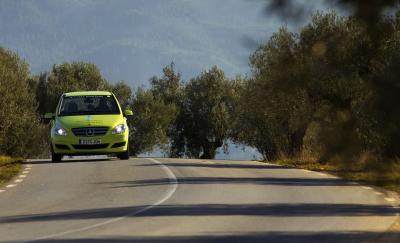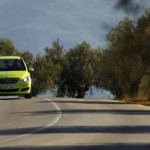
 On 7 March 2011, the F-CELL World Drive set out on the 10th daily stage in the USA, heading from San Diego to Los Angeles.
On 7 March 2011, the F-CELL World Drive set out on the 10th daily stage in the USA, heading from San Diego to Los Angeles.
In the metropolitan area of Los Angeles, the three B-Class F-CELL vehicles then experienced a first in the USA: for the first and only time on the North American leg, the vehicles could be refilled at a public hydrogen filling station. Prior to reaching this point, the F-CELL World Drive has already successfully crossed Southern Europe and the USA.
With the F-CELL World Drive, Mercedes-Benz is focusing global attention on the potential of e-mobility with fuel cell technology and is furthermore demonstrating impressively that this technology is ready for large-scale production. The next step to be taken for the industrialization of this guiding technology is the development of a comprehensive hydrogen infrastructure.
Infrastructure in the USA: California points the way forward
The F-CELL World Drive is particularly highlighting the still existing gaps of the global hydrogen infrastructure. By the end of the USA section of the tour on 18 March, the B-Class F-CELL vehicles will have been refuelled around 35 times on the route from Miami to Seattle – but only one of these refuelling procedures will have taken place at a public hydrogen filling station, located in the Greater Los Angeles Area.
“The American market is already active in the field of fuel cell technology, but like in Europe, there is still a need for development when it comes to infrastructure. Together with our regional partners, we want to point out the potentials of this technology and to get important lead markets ready for the rollout of a high number of electric vehicles with fuel cell technology,” says Dr. Thomas Weber, the Daimler AG Board Member responsible for Group Research and Development for Mercedes-Benz Cars. So far there are a few filling stations in California as well as on the East Coast of the USA, in the city of New York and also in Michigan. Most of the activities are currently taking place in California, however. Customers in the city of Los Angeles – where a number of Mercedes-Benz B-Class F-CELL vehicles have been on the road since the end of 2010 – can already refuel their vehicles at five public hydrogen filling stations. Of these, three are equipped with the latest – and meanwhile globally standardized –
700-bar technology which enables the tanks of B-Class vehicles to be filled in just three minutes for a range of about 400 kilometers.
Alongside further deliveries of B-Class vehicles with fuel cell drives to customers in the USA in 2011 and 2012, it is concretely planned to extend the supply network in American metropolitan areas. During a second stage they will then be linked up to each other. These steps will consequently spread fuel cell technology.
According to a study by UC Davis [1] , the basic supply of such zero-emission vehicles could be guaranteed with only about 40 hydrogen filling stations in the metropolitan area of Los Angeles. The State of California already provided an initial funding. Until today, 27 million US-Dollars went into the promotion of a hydrogen infrastructure. Another 14 million US Dollars is expected to be invested in 2011. For 2011 and 2012, the opening of further filling stations has been announced, four in the greater area of Los Angeles, two stations in the San Francisco Bay Area and 10 more stations in 2012. From 2012, a total of about 20 stations in California will supply electric vehicles with fuel cell technology with the necessary hydrogen.
These positive developments in the hydrogen infrastructure of California are also the result of Daimler AG’s almost 20-year commitment to fuel cell technology. For many years the company has been an active member of the California Fuel Cell Partnership (CaFCP), an amalgamation of automotive manufacturers, energy suppliers, government bodies and technology companies, and also the newly established Fuel Cell and Hydrogen Energy Association (FCHEA) in California.
The production of the necessary hydrogen today already provides a firm foundation for a future hydrogen infrastructure. The hydrogen industry in the USA could already supply up to 40 million vehicles. Pipelines, which can transport the hydrogen from the producers to the end-users, are already in place in many parts of the country.
A need for action in Europe
Prior to the US stage, the World Drive already clocked up more than 3600 kilometers in Europe, where the filling station network is also under development. Generally speaking, there is also capacity for hydrogen production. The long-term goal is to produce regenerative hydrogen, for example by means of wind, water or solar energy, geothermics or biomass, so that the entire energy chain, from production through to consumption by the vehicle, is emission-free or in other words CO2 neutral.
“The potentials of e-mobility with fuel cell technology are huge. If not now, when else is there a chance to establish Europe as the leading market for this future technology? Other nations are already on their way,” Thomas Weber reviews the current situation. For the ambitious goals of the European Union and the G8 countries include to cut overall CO2 emissions by 80 percent by the year 2050. Efforts are therefore being made in the transport sector to reduce CO2 output by 95 percent. Against this background, the use of electric vehicles using fuel cells and batteries is essential in order to make a significant contribution to long-term, sustainable mobility.
A recently published study investigating the potential of electrified drive systems in Europe came to the same conclusion [2] . Electric vehicles with fuel cell technology are also suitable for long journeys, which are usually made with medium-size and larger vehicles. These make up some 50 percent of total passenger car numbers and are also responsible for 75 percent of CO2 passenger car emissions. The fuel cell drive therefore represents an effective solution for the reduction of CO2-emissions in road traffic and has tremendous potential for mass production (1 million vehicles across Europe in 2020, or 25 percent of the market in 2050).
H2 Mobility – commitment to sustainable infrastructure measures in Germany
Daimler is active in a variety of different initiatives in order to drive forward the commercialisation of electric vehicles as well as the necessary infrastructure measures. Daimler AG has therefore launched an initiative together with Linde AG, for example, with the aim of developing a national hydrogen filling station infrastructure. In 2009 this resulted in the H2 Mobility initiative, through which major energy suppliers, corporations in the mineral oil industry and also other additional partners have come to an agreement on setting up a comprehensive hydrogen infrastructure in Germany. This is because a necessary prerequisite for the commercialisation of fuel cell vehicles is a corresponding hydrogen filling station network. Initial centres are in the process of development in large conurbations, such as Berlin and Hamburg. “We have invested successfully and to a large extend in the maturity of fuel cell technology in vehicle application. Now the infrastructure needs to be developed. We are convinced that these investments are not only worthwhile, but that there is no alternative for the sustainability of a demand meeting, individual mobility,” explains Thomas Weber.
Mercedes-Benz F-CELL World Drive
During the F-CELL World Drive, three Mercedes-Benz B-Class F-CELL vehicles are passing through 14 countries and 4 continents – to drive around the globe once. Organised by Mercedes-Benz, the circumnavigation of the world started on 30 January 2011 in Stuttgart and is scheduled to last 125 days, until the vehicles return to Stuttgart again at the beginning of June, after covering a distance of some 30,000 kilometres. The aim of the tour is to demonstrate the technical maturity and suitability for everyday use of electric vehicles with fuel cells, and at the same time highlight the need for the development of a comprehensive hydrogen infrastructure. Mercedes-Benz is being supported on the tour by Linde AG, which is responsible for supplying the hydrogen.



